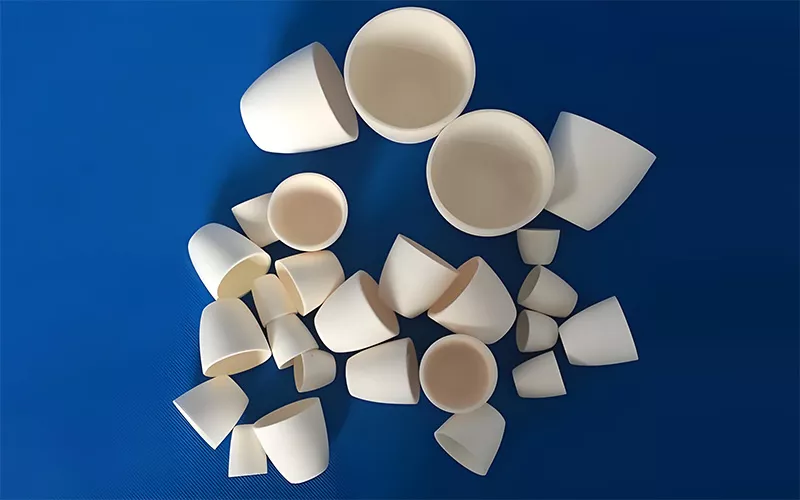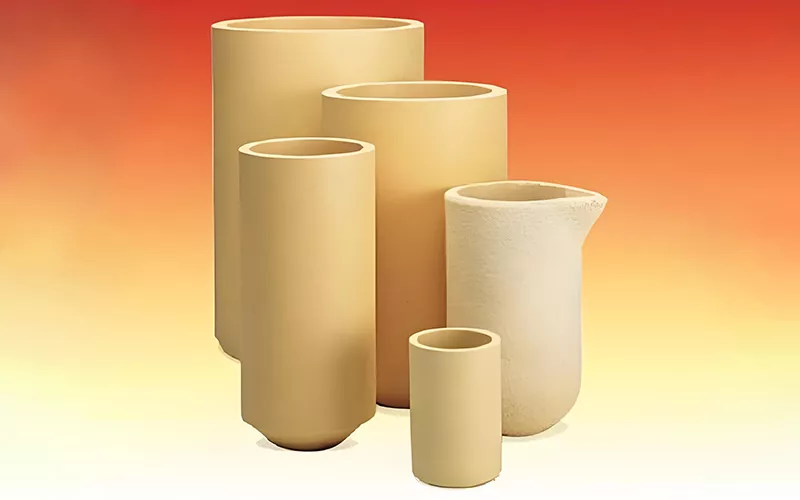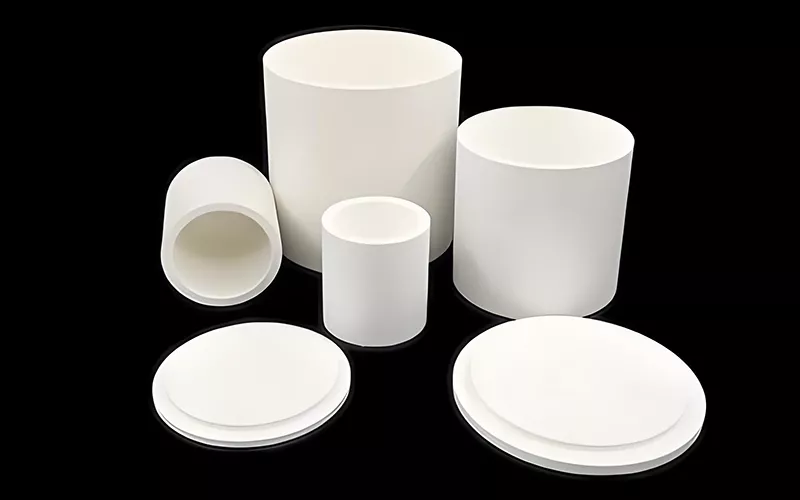Ceramic crucibles are containers with high melting points and high temperature resistance. They combine chemical stability with a low coefficient of thermal expansion, making them essential tools for extremely high-temperature applications in laboratories, metallurgy, semiconductor manufacturing, and other fields.
Ceramic crucibles are primarily made from advanced ceramics such as Aluminiumoxid, Bornitrid, Und Zirkonoxid. In this article, we’ll explore ceramic crucible material selection, key characteristics, and service life to help you select the most suitable crucible for your high-temperature application.

Aus welchen Materialien besteht ein Keramiktiegel?
Aluminiumoxidtiegel
Tiegel aus Aluminiumoxidkeramik are primarily made of 99.7% pure aluminum oxide. Did you know? During the production process, many manufacturers, such as GORGEOUS, add small amounts of magnesium oxide (MgO) and silicon dioxide (SiO2) to impart superior physical and chemical properties to the crucibles.
Key Features: High-Temperature Resistance - Alumina crucibles can withstand temperatures of approximately 1700°C in a redox atmosphere. While offering superior performance, alumina crucibles are also price-competitive, making them the preferred material for many manufacturers.
Applications: Alumina crucibles are primarily used in laboratory and industrial metallurgy, heating, and chemical reactions.
Advantages: Alumina crucibles are one of the most economical ceramic crucibles on the market. Alumina’s high melting point and low thermal expansion coefficient make them resistant to cracking. They are ideal reaction vessels for weakly alkaline substances.
Limitations: Strongly corrosive substances, such as the strong base sodium hydroxide (NaOH), can severely damage alumina crucibles. For these materials, GORGEOUS recommends using a crucible material with strong corrosion resistance instead of alumina crucible.
Zirkonia-Tiegel
Zirconia crucibles are primarily made of high-purity zirconium oxide. Their exceptionally high temperature resistance and chemical stability make them ideal for extremely high-temperature melting processes.
Key Features: Zirconia crucibles boast robust high-temperature resistance, capable of withstanding temperatures up to 2000°C, making them ideal for melting precious metals such as platinum (Pt) and palladium (Pd).
Zirconium oxide also possesses excellent chemical resistance, maintaining a stable structure even in harsh environments with strong acids and alkalis, making it an ideal crucible material for processes prone to corrosion.
Applications: Zirconia crucibles are primarily used in precious metal melting and certain processes involving high-melting-point materials.
Tiegel aus gehärtetem Zirkonoxid-Aluminiumoxid (ZTA-Tiegel)
Zirconia-toughened alumina crucibles (ZTA) are primarily made of 90% alumina and 10% zirconia. This ceramic material combines the advantages of both alumina and zirconia, offering excellent high-temperature resistance and high toughness.
Key Features:
High Toughness - The addition of zirconia significantly improves the crucible’s crack and wear resistance, reducing damage caused by high temperatures and mechanical shock.
High-Temperature Resistance - ZTA crucibles can withstand temperatures up to 1700°C and operate stably in high-temperature environments.
Thermal Shock Resistance - Compared to pure alumina crucibles, ZTA crucibles offer higher thermal shock resistance, are more stable under severe temperature fluctuations, and are less prone to cracking.
Applications: These crucibles are primarily used in processes requiring high mechanical strength and high-temperature stability.
Bornitrid-Tiegel (PBN-Tiegel)
Bornitrid-Tiegel are specially designed for use at extremely high temperatures. Their primary component is pyrolytic boron nitride.
Key Features:
High-Temperature Resistance - Boron nitride crucibles offer exceptional high-temperature resistance. In a protective atmosphere, they can reach temperatures of up to 2100°C and remain stable. They will not melt or react chemically with the substrate at extremely high temperatures.
Thermal Conductivity - Boron nitride crucibles have excellent thermal conductivity, allowing them to quickly dissipate heat, effectively preventing localized overheating, thermal stress, and thermal damage.
Low Thermal Expansion Coefficient - Boron nitride has a low thermal expansion coefficient, effectively reducing the risk of crucible cracking in high-temperature processes requiring rapid cooling or heating.
Applications: Boron nitride crucibles are primarily used in high-temperature processes such as semiconductor manufacturing and metal smelting. In the semiconductor industry, they are often used in chemical vapor deposition (CVD), crystal growth, and high-temperature evaporation.
Andere keramische Materialien
Neben den oben genannten gängigen Keramikmaterialien gibt es auch hochwertige Tiegelmaterialien wie Magnesiumoxid und Berylliumoxid. Sie alle zeichnen sich durch eine hervorragende Hochtemperaturbeständigkeit aus und sind wichtige Tiegelbehältermaterialien für viele Metallschmelzen und Labore.
Wie kann die Lebensdauer des Tiegels sichergestellt werden?
If you want your crucible to have better performance and service life, you’d better do the following:
Lagerung:
Gebrauchte Tiegel sollten am besten in einer trockenen, sauberen Umgebung gelagert werden, um Feuchtigkeitsaufnahme und Verunreinigungen zu vermeiden. Die Lagerung von Tiegeln in der Nähe von Chemikalien oder in Bereichen mit hoher Luftfeuchtigkeit sollte vermieden werden.
Arbeiten:
Sie sollten für die Bedienung des Tiegels geeignete Werkzeuge verwenden, direkten Kontakt mit den Händen vermeiden und ihn nach Gebrauch auf Risse oder Beschädigungen prüfen.
Reinigung:
Reinigen Sie den Tiegel nach jedem Gebrauch gründlich. Entfernen Sie alle Rückstände und lassen Sie ihn vor der Reinigung gut abkühlen, um einen Thermoschock und Risse zu vermeiden.
Häufig gestellte Fragen
1. Was ist ein Tiegel?
Ein Tiegel ist ein Behälter, der für den Einsatz bei extrem hohen Temperaturen konzipiert ist und hauptsächlich zum Schmelzen von Metallen und für chemische Reaktionen verwendet wird.
2. Was ist der Schmelzpunkt eines Keramiktiegels?
Der Schmelzpunkt eines Keramiktiegels hängt hauptsächlich vom verwendeten Material ab. Beispielsweise hält ein Aluminiumoxidtiegel Temperaturen zwischen 1650 °C und 1700 °C stand, während ein Zirkonoxidtiegel Temperaturen bis zu 2000 °C standhält.
3. Welche Verwendung finden Keramiktiegel in der Chemie?
Keramiktiegel werden häufig zum Schmelzen von Metallen bei hohen Temperaturen, als Behälter für chemische Reaktionen, Behälter für die Materialverarbeitung usw. verwendet.
4. Was ist die Funktion eines Keramiktiegels?
Keramiktiegel werden hauptsächlich für Hochtemperatur-Heizanwendungen, zum Schmelzen oder Raffinieren von Materialien usw. verwendet. Sie können auch als Behälter für bestimmte chemische Reaktionen dienen.
5. Welche Materialeigenschaften haben Keramiktiegel?
Keramische Werkstoffe zeichnen sich durch einen hohen Schmelzpunkt, einen niedrigen Wärmeausdehnungskoeffizienten, eine gute Wärmestabilität und chemische Korrosionsbeständigkeit aus.
6. Können Keramiktiegel zum Schmelzen stark alkalischer Substanzen verwendet werden?
Dies hängt hauptsächlich vom Material des Tiegels ab. Generell raten wir davon ab, Aluminiumoxidtiegel zum Schmelzen stark alkalischer Substanzen wie Natriumhydroxid (NaOH) und Natriumperoxid (Na₂O₂) zu verwenden, da diese Substanzen den Tiegel korrodieren können.
7. Was ist der Unterschied zwischen einem Porzellantiegel und einem Keramiktiegel?
Porzellantiegel bezeichnet üblicherweise einen Tiegel aus Porzellanmaterial. Keramiktiegel sind leistungsfähiger als herkömmliche Porzellantiegel, halten höheren Temperaturen stand und verfügen über bessere mechanische Eigenschaften.
8. Wie erhitzt man einen Keramiktiegel?
Beim Erhitzen eines Keramiktiegels sollten Sie entsprechend den Eigenschaften des Tiegelmaterials eine geeignete Heizmethode wählen. Es ist zu beachten, dass während des Erhitzens ein plötzliches Abkühlen oder Erhitzen vermieden werden sollte, da dies zu Rissen im Tiegel führen kann.
9. Welche Wartungsmethoden gibt es für Keramiktiegel?
Nach der Verwendung sollten Sie den Tiegel gründlich reinigen, um Rückstände zu entfernen, ihn mit einer geeigneten Reinigungslösung reinigen und ihn anschließend mit reinem Wasser abspülen und für die spätere Verwendung trocknen.
Abschluss
Ceramic crucibles are indispensable tools in modern chemistry and metallurgy. Capable of operating in extreme temperatures and harsh chemical environments, they play a key role in a wide range of scientific and industrial applications. GORGEOUS, a leading international supplier of advanced ceramics, offers custom-made ceramic crucibles in a variety of materials. Thank you for reading this article, and we hope you find it helpful.